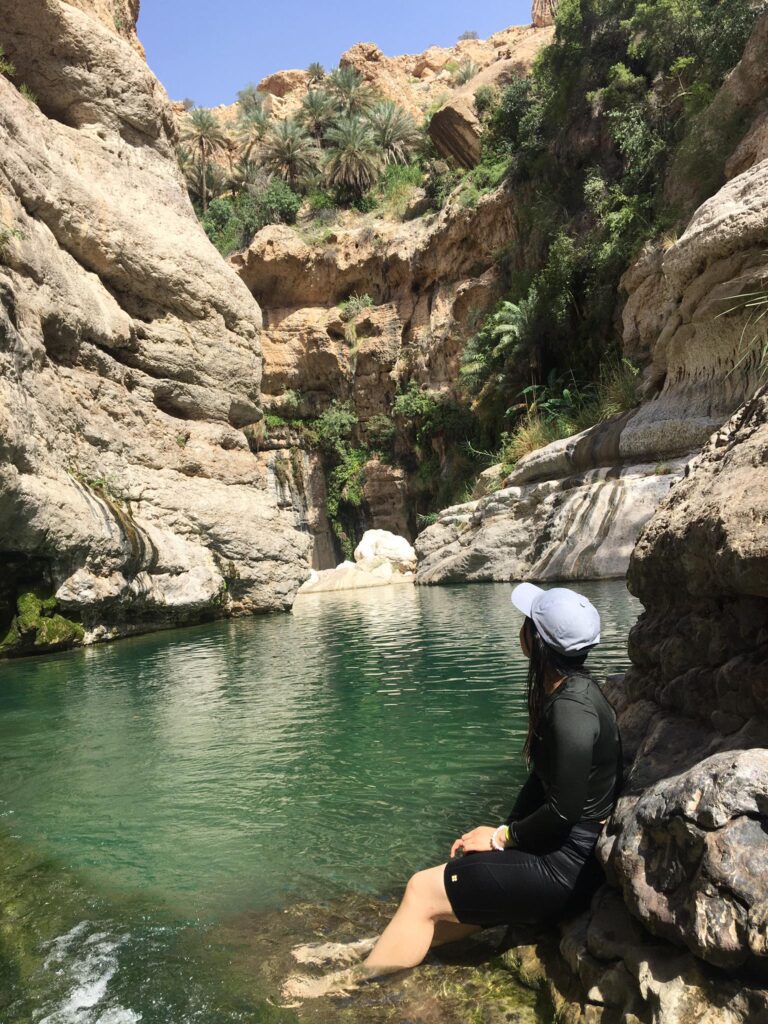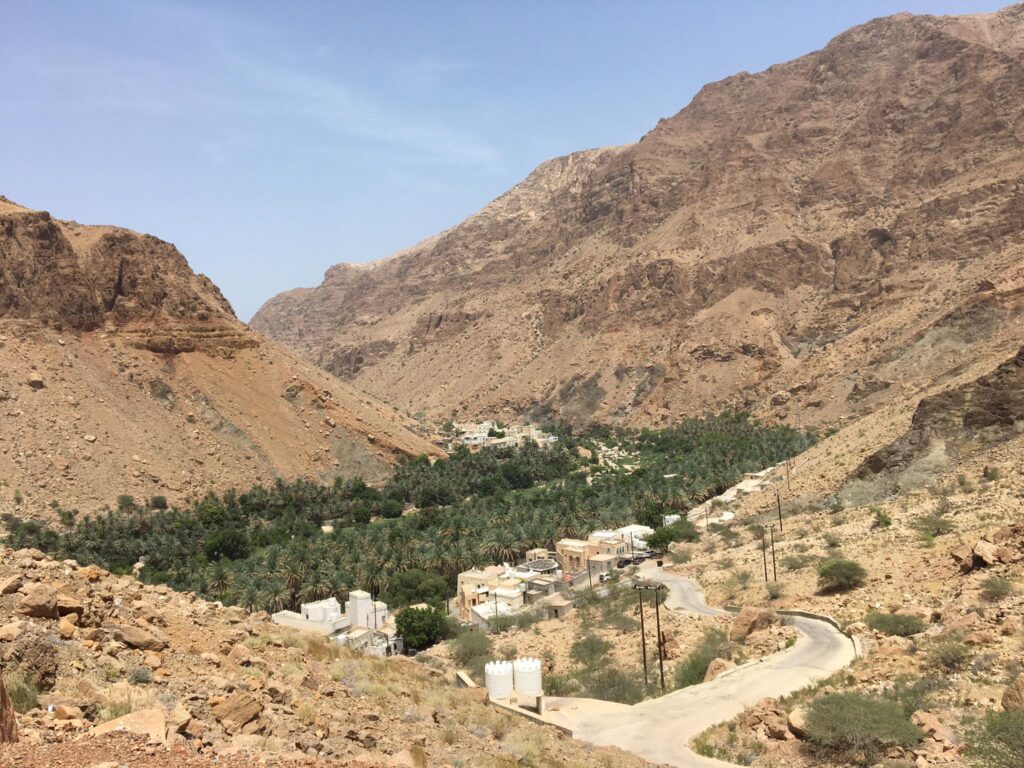Oman has been one of those destinations that has kept me wanting more. It’s a place I can’t help but talk about every time I have the opportunity to. Compared to its neighboring cities of Dubai, Abu Dhabi and Doha, Muscat seems like their humble cousin. Oman is rather wealthy yet skyscrapers are not to be found. In fact, there is a rule that limits the height and color of buildings to create uniformity and preserve the traditional Middle Eastern style and culture.
What I found most intriguing upon my visit to Muscat was how diverse the landscape was. It is situated along the Gulf of Oman, blessed with deserts, mountains, valleys and beaches. It honestly took me a while wrap my head around how different Oman was. Furthermore, it has a rich history with the Ottomans, Portuguese and Persians and the influences are still heavily present.
Besides the nature of Oman, another thing that stood out was the friendliness and hospitality of the locals. Everyone I met was so welcoming and there is such an authentic charm to them. The local males were easily noticed in their local attire. White robes (dishdasha) and embroidered traditional cap (kummas). I have had the fortune to meet some of the nicest and welcoming people here that I now call as friends.
Here is a 3-day itinerary that will hopefully inspire you to make a trip to Muscat, or anywhere in Oman! Also check out this guide and some paid tour options while you’re in Muscat.
DAY 1:
- For this itinerary, I’d suggest starting off exploring the beautiful nature that Oman has to offer. It’s going to be a day filled with hiking, climbing and some swimming so be prepared! There will be a lot of driving involved so pack some snacks and wear comfortable clothing and shoes (water shoes will be even better if you have them!)
- First stop for today will be to Bimmah Sinkhole. This is a limestone sinkhole just 600 m from the sea, the beautiful turquoise waters will tempt you to jump right in. It is a popular spot for a refreshing dip and temporary relief from the heat especially during summer months.
- A very popular spot for tourists and locals is the Wadi Shab. However, it can get quite busy especially during the weekends. I tend to prefer the less touristy spots which are often quieter and equally as beautiful. That is why I suggest heading to Wadi Tiwi.
- It is about a 10km drive through a palm tree plantation estate but the roads are cement covered. Along the drive you will be able to see different local villages, farms and different plantations.
- A short hike through the plantation will bring you to the Wadi, there are several ‘entrances’ so you may start at different parts of the Wadi. This wadi is particularly known for its rocky cliffs, turquoise pools and its submerged cave with waterfalls.
- You can easily spend hours here just taking in the stunning landscape and greenery. In fact, if you’re lucky, you may just have the whole place to yourself with several people coming and going.
- A wonderful thing in Oman is that you are able to pitch tents and camp almost anywhere as it is legal. I’ve heard from locals that some people choose to camp overnight in this Wadi. If that’s what you’re interested in, make sure to plan in advance so you have all the necessary equipment and necessities.
- If not, after enjoying your time here in Wadi Tiwi, head back to the city to have some delicious dinner and have an early night to rest up.


DAY 2:
- For day 2, opt to explore the city and have a slightly chilled day. First up will be the biggest mosque in Oman – the Sultan Qaboos Grand Mosque. The capacity of this mosque is 20000 worshippers. It is a modern mosque with an incredible attention to detail. The 24-karat gold plated chandelier in the male prayer room is definitely one of the highlights.
- For non-muslim visitors, it is allowed for entry from 8AM-11AM except on Fridays. Ladies need to be covered from head to toe (including the head scarf) and men must be in long trousers.
- After that, stop by the Royal Opera House before heading to the upscale area of Qurum. Stop by Dukanah restaurant for a local Omani fare. You can also have a lovely stroll along the Qurum beach after your meal.
- If you’re interested, you can also visit the National Musuem of Oman to learn more about its history and culture. Then, head towards the old part of Muscat, Muttrah. It is home to one of the oldest markets, Muttrah Souq. This part of Muscat showcases an authentic, unpolished side of the city. Get lost in the market as you wander around in search for the best deals on frankincense, spices and other local trinkets.
- Catch sunset at the Muttrah Fort and if you have some energy, go for a walk along the Corniche to immerse yourself in the daily lives of locals and expats.
- Pop into any restaurants serving fresh seafood for a treat!
DAY 3:
- Start your day bright and early to catch a tour to Ad Dimaniyat Islands, a protected natural reserve. There are many half-day tours that have the option to swim and snorkel, if you are a diver, it is also possible to have a dive trip.
- From my experience, I was able to witness sea turtles, dolphins and colorful fishes. Some people from my group also saw white-tipped reef sharks and if you’re really lucky, the gentle giants – whale sharks also swim by the area.
- Most tour operators arrange lunch on board so you just need to meet them at the designated area and enjoy yourself.
- There are also other options to consider on this day if you’re not into swimming or snorkeling. There are many hiking trails or if you’re into history, Nizwa Fort is a good place to consider.
- End your day at one of the many beach clubs sprawled around the city to enjoy the nightlife in Muscat.
GETTING AROUND:
- Walking: The layout of Muscat is very spread out and attractions are often far from one another. While it is possible to walk around certain areas of Muscat such as Mutrah Corniche and Old Muscat. Bear in mind that walking long distances may not be practical for every location due to the distances and weather.
- Bicycling: Bicycling is not a common mode of transportation in Muscat and dedicated cycling infrastructure is limited. However, there are some areas, such as Al Mouj (The Wave) and certain beachfront promenades, where you can find bicycle rental services. It’s advisable to inquire about availability and rental options in these specific areas.
- Public Transport: Muscat has an efficient public transport system called Mwasalat, which operates buses connecting different parts of the city and surrounding areas. The bus network covers major attractions, residential areas, and commercial hubs. The fares are affordable, and it’s a convenient way to get around Muscat. Do take note that buses don’t run as regularly so plan ahead if you are opting to take buses.
- Car Rental: Renting a car in Muscat is a popular option for visitors who prefer more flexibility in their travels, prices of petrol are also relatively cheap. Several car rental companies offer services at the Muscat International Airport and in various parts of the city. Metered taxis are also readily available in Muscat for shorter journeys, and ride-hailing applications like Uber are operational in the city as well.
TIPS:
- Language: Arabic is the official language of Oman. It is widely spoken by the local population. In tourist destinations and urban areas, English is commonly understood. Some basic arabic phrases that may help are “Thank You” – “Shukran” or “Good Morning” – “Sabah Al Khair”
- Currency: The currency used in Oman, is the Omani Rial (OMR). It is often denoted with the symbol “OMR”. ATMs are widely available throughout the country, and major credit cards are accepted in most establishments. However, it’s advisable to carry some cash for smaller transactions or in less touristy areas.
- Tipping: Tipping in Muscat, is not obligatory but is generally appreciated for good service. In restaurants, a service charge is often included in the bill. If it is not included, leaving a gratuity of 10-15% of the total bill is customary. Tipping hotel staff, taxi drivers, and tour guides for exceptional service is also common.
- Safety: Oman is considered a safe country. Muscat, as the capital city, maintains a relatively low crime rate. However, it’s always recommended to take general safety precautions, such as keeping an eye on your belongings and being aware of your surroundings, particularly in crowded areas or tourist attractions.
- Climate: Muscat experiences a hot desert climate. Summers (April – October) are extremely hot, with temperatures often exceeding 40°C (104°F). It’s essential to stay hydrated, wear sun protection, and seek shade during the hottest hours of the day. Winters (November – March) are mild, with temperatures ranging from 20°C to 30°C (68°F to 86°F), making it a more comfortable time to explore outdoor attractions.
- Visa: Visa requirements for Oman depend on your nationality and the purpose and duration of your visit. Citizens of many countries can obtain a visa on arrival at the airport, including Muscat International Airport, for various durations ranging from 10 days to 30 days. However, it’s advisable to check the specific visa requirements for your country and ensure you have the necessary documentation before traveling to Muscat.
